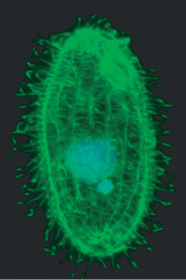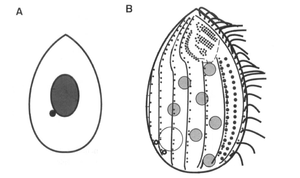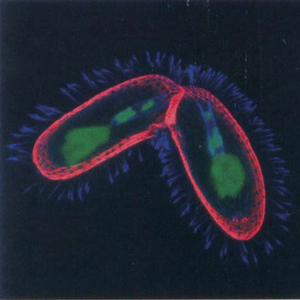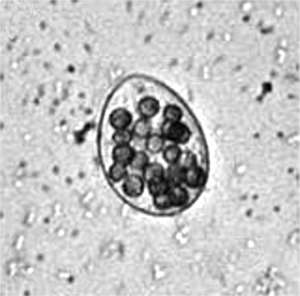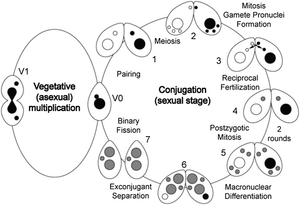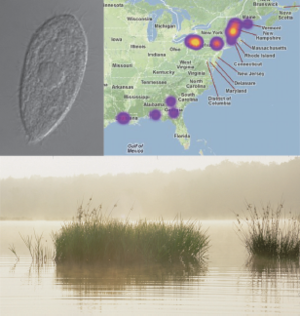Tetrahymena thermophila
Classification
Higher order taxa
Eukaryota; Chromalveolata; Ciliophora; Oligohymenophorea; Hymenostomatida; Tetrahymenidae
Species
Tetrahymena thermophila
Description and Significance
Tetrahymena thermophila is a large, motile, phagocytic, unicellular eukaryote. The organism is about 20x50µm. T. thermophila live in temperate freshwater environments. With a doubling time of less than 2 hours, it is considered one of the fastest growing eukaryotes. It can readily grow to a high density on a wide range of media, with a temperature range of 12°C to 41°C.
T. thermophila is an essential model organism that has been used in many biochemical experiments to study biological phenomena. Currently this organism is being used to study four major issues: cilia biogenesis, telomerase structure and function, small RNA mediated self versus non-self discrimination, and epigenetic inheritance.
Describe the appearance, habitat, etc. of the organism, and why you think it is important.
Genome Structure
T. thermophila contain two nuclei, a macronucleus and a micronucleus. Each has been sequenced[1]. The macronucleus is ultimately derived from the micronucleus. The micronucleus is diploid and contains 5 pairs of chromosomes. The macronucleus contains 45 copies of 275 chromosomes formed by fragmentation, as well as 9000 copies of the rRNA gene. The macronucleus contains 15% less genetic information than the micronucleus, which represents noncoding DNA and transposable elements. The macronucleus is kept intact through asexual reproduction by telomerase activity. Additionally the mitochondrial genome has been sequenced [2].
Cell Structure
Tetrahymena thermophila has all the basic structures of animal cells (ER, golgi, mitochondria, actin, tubulin etc.) except intermediate filaments. Additionally T. thermophila contain enlarged food vacuoles and a contractile vacuole which aids in regulating osmotic pressure. The cell has 18-21 rows of cilia lining its cell membrane. The cilia contain phosphonolipds which are resistant to degradation by phospholipase. Food enters the organism through the oral apparatus and exits through the cytoproct.
Metabolism
T. thermophila obtains energy through aerobic respiration. In lab T. thermophilas generation time is between 2-3 hours. It requires 11 essential amino acids, six B-complex vitamins, Fe3+ and trace metals. Additionally it is unable to synthesize purines and pyrimidines. The lack of synthetic pathways reflects T. thermophilas obligate predatory lifesyle in nature.
How it gains energy; what important molecules it produces.
Life Cycle
The presence of the two nuclei reflects T. thermophila’s ability to reproduce both sexually and asexually. During vegetative growth the macronucleus is transcribed, translated and transmitted to the next asexual generation by mitosis. Food stress induces T. thermophila to reproduce sexually, producing pronuclei by meiosis of the micronucleus and exchange with a cell of a different mating type. The macronucleus is ultimately derived from the micronucleus.
T. thermophila has four distinct phases in its' life cycle: conjugation, immaturity, maturity, and senility. Conjugation is the sexual stage of the life cycle, in which two cells pair up to from a temporary junction to exchange gamete nuclei. The mating cells further generate and differentiate the necessary nuclear structures for their sexual progeny. During conjugation the essential nuclear events include meiosis, gamete nucleus formation, and fertilization, and nuclear differentiation.
Ecology and Pathogenesis
Tetrahymena thermophila is common in fresh water ponds throughout Eastern North America, particularly those that do not completely ice over during the winter months. T. thermophila distribution is very localized; this contrasts with the idea that "everything is everywhere". The organism is most abundant June through September. It is often found in proximity to decaying vegetation.
T. thermophila is a promising organism for monitoring the toxicity chemical compounds and testing water quality.
Habitat; symbiosis; biogeochemical significance; contributions to environment.
If relevant, how does this organism cause disease? Human, animal, plant hosts? Virulence factors, as well as patient symptoms.
References
Author
Page authored by Hannah Pak and Luke Pryke, students of Prof. Jay Lennon at Indiana University.
